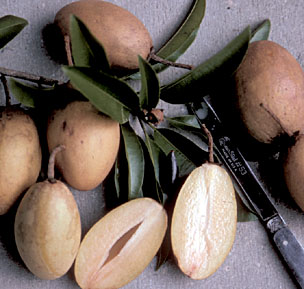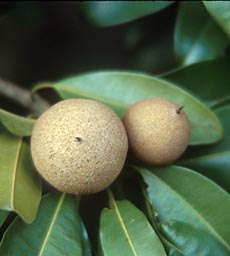
Sapodilla
Manilkara zapota
Noris Ledesma, Curator of Tropical Fruit

I'm sure that visitors to the Garden who have been to the Garden Café have enjoyed the shade from the giant sapodilla that shelters the outdoor patio. This particular tree is one of the trees that was on the site before the Garden was created in 1938.
This wonderful sapodilla specimen was grown from a seed, which accounts for its size, height and fruit quality. However, the Tropical Fruit Program now has new cultivars which can be kept a more manageable size by pruning and yet still produce superior fruit. Some may be maintained at no more than siz feet, making them ideal for a small courtyard or patio. They have very few pest or disease problems.
When the Spanish arrived in the Yucatan they took note of the sapodilla and how the Maya esteemed it. They described it as dainty, well tasting and very delicate. Its appeal quickly spread throughout Southeast Asia. Each region selected for its specific tastes and preferences. The result is precocious, dwarf selections with exceptional horticultural traits and eating quality.

The sapodilla is in the family sapotaceae and is also called chico sapote, chicle and nispero. It is native to the Yucatan in Mexico and other Central American regions. It is considered evergreen and has a spectacular pyramidal canopy. Its polinitation is by insects and bats. The fruit are conical to oval with a diameter of 2-4.5 inch; weight from 100 - 400 g depending on cultivar.
Sapodilla fruit are soft, sweet and have a beautiful smell when ripe. The fruit has a flavor that is a combination of peaches, pears, brown sugar, cinnamon and a little brandy. The sapodilla is delicious to eat out of hand, but can also be made into a great dessert sauce or mousse. A grafted tree produces fruit in 3 years. It is often difficult to tell when a sapodilla is ready to pick. If the skin is brown and the fruit is soft it is fully mature. To ripen sapodilla fruits, it is important to wash them with clean water removing the latex and place at room temperature for few days to soften. The fruit can be used fresh or frozen. For longer storage, (6 months) pulp should be removed from the fruit and frozen.
The 'O-1' is among the best of Central American cultivars; grafted sapodillas include 'Alano', 'OX', and 'Makok'.
Níspero
Cuando los españoles llegaron a Yucatán, observaron al níspero y lo apreciaron al igual que los Mayas lo hicieron. Lo describieron como una fruta de delicado y buen sabor. Su atractivo se disperso rápidamente a través de Asia suroriental. Cada región seleccionó sus preferencias y gustos específicos, el resultado son selecciones precoces, enanas con rasgos hortícolas excepcionales y de alta calidad.